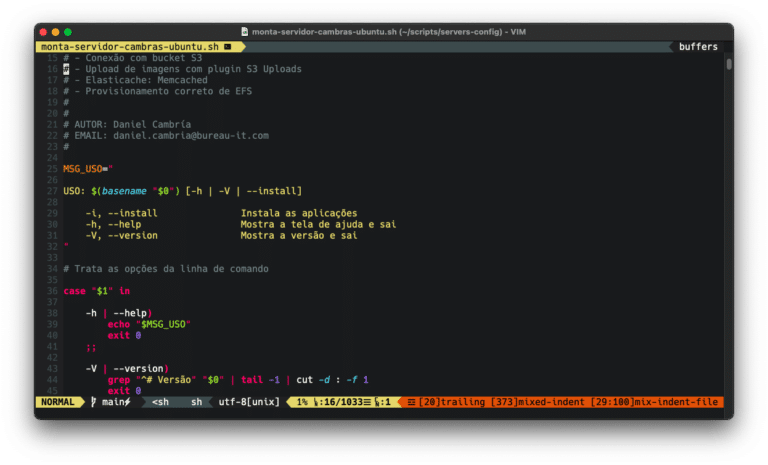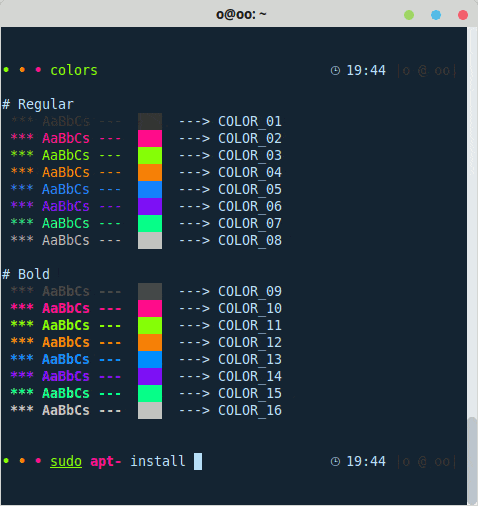Tempo di lettura stimato: 15 minuti
Modalità di utilizzo
Prima di tutto.
bc Per iniziare è importante sapere che ci sono due modi per utilizzarlo: in modalità interattiva o non interattiva.
bc Utilizzare la modalità interattiva è facile, basta digitare e avviare i comandi.
$ bc bc 1.06 Copyright 1991-1994, 1997, 1998, 2000 Free Software Foundation, Inc. This is free software with ABSOLUTELY NO WARRANTY. For details type `warranty'. 1+1 2
In modalità non interattiva, devi passare una stringa allo stdin del bc in qualche modo. echo, printf, pipe, qui stringhe… scegli il metodo più comodo e procedi. Vediamo alcuni esempi:
$ echo "10*10" | bc #via pipe 100
$ bc <<< "10-3" #via here strings 7
Variabili
bc ha 4 importanti variabili che utilizza internamente:
ibase #base dos números de entrada (input) no cálculo obase #base do número do resultado (de saída, output) do cálculo scale #define a quantidade de dígitos após a vírgula após operações de divisão last #repete o último número calculado
Puoi anche definire le tue variabili, ma sempre in minuscolo.
$ bc bc 1.06 Copyright 1991-1994, 1997, 1998, 2000 Free Software Foundation, Inc. This is free software with ABSOLUTELY NO WARRANTY. For details type `warranty'.a = 1 b = 2 c = a + b c 3
Il bc non tollera i bins alti nelle variabili, ma richiede bins alti per tutte le voci esadecimali! Tieni presente questo aspetto =)
Conversioni esadecimali, decimali, ottali, binarie e simili…
Questa calcolatrice diventa ancora più interessante quando dobbiamo cambiare le basi. Ad esempio, per convertire l’esadecimale (base 16) in decimale (base 10), basta cambiare le variabili ibase (ingresso) e obase (uscita). Entrambe sono in base 10 per impostazione predefinita. Quindi cambiamo solo ibase, dato che l’output sarà decimale per impostazione predefinita:
$ echo "ibase=16; FF" | bc 255
ibase obase Oppure per convertire dalla base 16 (esadecimale) alla base 2 (binaria) con gli argomenti (input) e (output) dichiarati insieme:
$ echo "ibase=16; obase=2; FF" | bc 11111111
Operatori
Le basi:
+ addizione – sottrazione * moltiplicazione / divisione % resto ^ potenza
Ecco bc in azione con alcuni comandi e i miei commenti a fianco (sì, accetta i commenti usando # dopo ogni comando).
bcPer entrare in modalità interattiva, basta richiamare il comando .
$ bc -q 10*10 #cálculo com base 10, default 100 ibase=16 #alteração do input para base 16 (hex) FF 255 #output de FF FF*2 510 #output de FF*2 obase=2 #troca a base do output para 2 (binário) FF 11111111 #resultado de FF FF*2 111111110 #resultado de FF*2 ibase=2 #troca base do input para 2 obase=A #troca base do output para 10 (escrito em hex). Aqui tem uma pegadinha, se colocar 10 o BC irá se perder. obase #chama a variável obase 10 #exibe o valor que consta na variável obase, igual no python 🙂 11111111 255 #resultado de 11111111 em decimal last #exibe o último resultado 255 scale=3 #define os dígitos após vírgula 23/3 7.666 quit #sai do bc interativo
Altre funzioni
Hai bisogno di altro? Logaritmo, seno, coseno, tangente e così via? Usa la libreria matematica di bc con l’opzione –mathlib
$ bc --mathlib s(1) .84147098480789650665 c(1) .54030230586813971740 a(1) .78539816339744830961
E il bc può anche creare programmi!
Guarda questo esempio tratto dal manuale del bc, il libro degli assegni.
Salva il codice qui sotto in un file qualsiasi, ad esempio checkbook.bc
scale=2
print "\nCheck book program!\n"
print " Remember, deposits are negative transactions.\n"
print " Exit by a 0 transaction.\n\n"
print "Initial balance? "; bal = read()
bal /= 1
print "\n"
while (1) {
"current balance = "; bal
"transaction? "; trans = read()
if (trans == 0) break;
bal -= trans
bal /= 1
}
quit
Ora eseguilo.
$ bc -q checkbook.bc Check book program! Remember, deposits are negative transactions. Exit by a 0 transaction. Initial balance? 2 current balance = 2.00 transaction? 1 current balance = 1.00 transaction? 1 current balance = 0 transaction? 1 current balance = -1.00 transaction? 0 quit
Ci sono molte altre funzioni nel bc, che vale la pena esplorare se vuoi approfondire l’argomento. Il manuale del bc è molto interessante, vale sicuramente la pena darci un’occhiata.
Ma prima di concludere l’articolo, dai un’occhiata a questo enorme archivio di funzioni bc!
#!/usr/local/bin/bc -l
### Funcs.BC - a large number of functions for use with GNU BC
## Not to be regarded as suitable for any purpose
## Not guaranteed to return correct answers
scale=50;
define pi() {
auto s;
if(scale==(s=scale(pi_)))return pi_
if(scale<s)return pi_/1
scale+=5;pi_=a(1)*4;scale-=5
return pi_/1
}
e = e(1);
define phi(){return((1+sqrt(5))/2)} ; phi = phi()
define psi(){return((1-sqrt(5))/2)} ; psi = psi()
# Reset base to ten
obase=ibase=A;
## Integer and Rounding
# Round to next integer nearest 0: -1.99 -> 1, 0.99 -> 0
define int(x) { auto os;os=scale;scale=0;x/=1;scale=os;return(x) }
# Round down to integer below x
define floor(x) {
auto os,xx;os=scale;scale=0
xx=x/1;if(xx>x).=xx--
scale=os;return(xx)
}
# Round up to integer above x
define ceil(x) {
auto os,xx;x=-x;os=scale;scale=0
xx=x/1;if(xx>x).=xx--
scale=os;return(-xx)
}
# Fractional part of x: 12.345 -> 0.345
define frac(x) {
auto os,xx;os=scale;scale=0
xx=x/1;if(xx>x).=xx--
scale=os;return(x-xx)
}
# Absolute value of x
define abs(x) { if(x<0)return(-x)else return(x) }
# Sign of x
define sgn(x) { if(x<0)return(-1)else if(x>0)return(1);return(0) }
# Round x up to next multiple of y
define round_up( x,y) { return(y*ceil( x/y )) }
# Round x down to previous multiple of y
define round_down(x,y) { return(y*floor(x/y )) }
# Round x to the nearest multiple of y
define round( x,y) {
auto os,oib;
os=scale;oib=ibase
.=scale++;ibase=A
y*=floor(x/y+.5)
ibase=oib;scale=os
return y
}
# Find the remainder of x/y
define int_remainder(x,y) {
auto os;
os=scale;scale=0
x/=1;y/=1;x%=y
scale=os
return(x)
}
define remainder(x,y) {
os=scale;scale=0
if(x==x/1&&y==y/1){scale=os;return int_remainder(x,y)}
scale=os
return(x-round_down(x,y))
}
# Greatest common divisor of x and y
define int_gcd(x,y) {
auto r,os;
os=scale;scale=0
x/=1;y/=1
while(y>0){r=x%y;x=y;y=r}
scale=os
return(x)
}
define gcd(x,y) {
auto r,os;
os=scale;scale=0
if(x==x/1&&y==y/1){scale=os;return int_gcd(x,y)}
scale=os
while(y>0){r=remainder(x,y);x=y;y=r}
return(x)
}
# Lowest common multiple of x and y
define int_lcm(x,y) {
auto r,m,os;
os=scale;scale=0
x/=1;y/=1
m=x*y
while(y>0){r=x%y;x=y;y=r}
m/=x
scale=os
return(m)
}
define lcm(x,y) { return (x*y/gcd(x,y)) }
# Remove largest possible power of 2 from x
define oddpart(x){
auto os;
os=scale;scale=0;x/=1
if(x==0){scale=os;return 1}
while(!x%2)x/=2
scale=os;return x
}
# Largest power of 2 in x
define evenpart(x) {
auto os;
os=scale;scale=0
x/=oddpart(x/1)
scale=os;return x
}
## Trig / Hyperbolic Trig
# Sine
define sin(x) { return s(x) } # alias for standard library
# Cosine
define c(x) { return s(x+pi()/2) } # as fast or faster than
define cos(x) { return c(x) } # . standard library
# Tangent
define tan(x) { auto c;c=c(x);if(c==0)c=A^-scale;return(s(x)/c) }
# Secant
define sec(x) { auto c;c=c(x);if(c==0)c=A^-scale;return( 1/c) }
# Cosecant
define cosec(x) { auto s;s=s(x);if(s==0)s=A^-scale;return( 1/s) }
# Cotangent
define cotan(x) { auto s;s=s(x);if(s==0)s=A^-scale;return(c(x)/s) }
# Arcsine
define arcsin(x) { if(x==-1||x==1)return(pi()/2*x);return( a(x/sqrt(1-x*x)) ) }
# Arccosine
define arccos(x) { if(x==0)return(0);return pi()/2-arcsin(x) }
# Arctangent (one argument)
define arctan(x) { return a(x) } # alias for standard library
# Arctangent (two arguments)
define arctan2(x,y) {
auto p;
if(x==0&&y==0)return(0)
p=(1-sgn(y))*pi()*(2*(x>=0)-1)/2
if(x==0||y==0)return(p)
return(p+a(x/y))
}
# Arcsecant
define arcsec(x) { return( a(x/sqrt(x*x-1)) ) }
# Arccosecant
define arccosec(x) { return( a(x/sqrt(x*x-1))+pi()*(sgn(x)-1)/2 ) }
# Arccotangent (one argument)
define arccotan(x) { return( a(x)+pi()/2 ) }
# Arccotangent (two arguments)
define arccotan2(x,y) { return( arctan(x,y)+pi()/2 ) }
# Hyperbolic Sine
define sinh(x) { auto t;t=e(x);return((t-1/t)/2) }
# Hyperbolic Cosine
define cosh(x) { auto t;t=e(x);return((t+1/t)/2) }
# Hyperbolic Tangent
define tanh(x) { auto t;t=e(x+x)-1;return(t/(t+2)) }
# Hyperbolic Secant
define sech(x) { auto t;t=e(x);return(2/(t+1/t)) }
# Hyperbolic Cosecant
define cosech(x) { auto t;t=e(x);return(2/(t-1/t)) }
# Hyperbolic Cotangent
define coth(x) { auto t;t=e(x+x)-1;return((t+2)/t) }
# Hyperbolic Arcsine
define arcsinh(x) { return( l(x+sqrt(x*x+1)) ) }
# Hyperbolic Arccosine
define arccosh(x) { return( l(x+sqrt(x*x-1)) ) }
# Hyperbolic Arctangent
define arctanh(x) { return( l((1+x)/(1-x))/2 ) }
# Hyperbolic Arcsecant
define arcsech(x) { return( l((sqrt(1-x*x)+1)/x) ) }
# Hyperbolic Arccosecant
define arccosech(x) { return( l((sqrt(1+x*x)*sgn(x)+1)/x) ) }
# Hyperbolic Arccotangent
define arccoth(x) { return( l((x+1)/(x-1))/2 ) }
# Length of the diagonal vector (0,0)-(x,y) [pythagoras]
define pyth(x,y) { return(sqrt(x*x+y*y)) }
define pyth3(x,y,z) { return(sqrt(x*x+y*y+z*z)) }
# Gudermannian Function
define gudermann(x) { return 2*(a(e(x))-a(1)) }
# Inverse Gudermannian Function
define arcgudermann(x) {
return arctanh(s(x))
}
# Bessel function
define besselj(n,x) { return j(n,x) } # alias for standard library
## Exponential / Logs
# Exponential e^x
define exp(x) { return e(x) } # alias for standard library
# Natural Logarithm (base e)
define ln(x) {
auto os,len,ln;
if(x< 0){print "ln error: logarithm of a negative number\n";return 0}
if(x==0)print "ln error: logarithm of zero; negative infinity\n"
len=length(x)-scale(x)-1
if(len<A)return l(x);
os=scale;scale+=length(len)+1
ln=l(x/A^len)+len*l(A)
scale=os
return ln/1
} # speed improvement on standard library
# workhorse function for pow and log - new, less clever version
# Helps determine whether a fractional power is legitimate for a negative number
# . expects to be fed a positive value
# . returns -odd for even/odd; odd2 for odd1/odd2;
# even for odd/even; -2 for irrational
# . note that the return value is the denominator of the fraction if the
# fraction is rational, and the sign of the return value states whether
# the numerator is odd (positive) or even (negative)
# . since even/even is not possible, -2 is used to signify irrational
define id_frac2_(y){
auto os,oib,es,eps,lim,max,p,max2,i,cf[],f[],n,d,t;
os=scale
if(cf_max){
# cf.bc is present!
.=cf_new(cf[],y);if(scale(cf[0]))return -2;
.=frac_from_cf(f[],cf[],1)
d=f[0];scale=0;if(f[1]%2==0)d=-d;scale=os
return d
}
oib=ibase;ibase=A
scale=0
es=3*os/4
scale=os
eps=A^-es
y+=eps/A
scale=es
y/=1
scale=0
if(y<0)y=-y
d=y-(n=y/1)
if(d<eps){t=2*(n%2)-1;scale=os;ibase=oib;return t}#integers are x/1
t=y/2;t=y-t-t
# Find numerator and denominator of fraction, if any
lim=A*A;max2=A^5*(max=A^int(os/2));p=1
i=0;y=t
while(1) {
scale=es;y=1/y;scale=0
y-=(t=cf[++i]=y/1);p*=1+t
if(i>lim||(max<p&&p<max2)){cf[i=1]=-2;break}#escape if number seems irrational
if((p>max2||3*length(t)>es+es)&&i>1){cf[i--]=0;break}#cheat: assume rational
if(y==0)break;#completely rational
}
n=1;d=cf[i]
if(i==0){print "id_frac2_: something is wrong; y=",y,", d=",d,"\n"}
if(d!=-2&&i)while(--i){d=n+cf[i]*(t=d);n=t}
if(d<A^os){d*=2*(n%2)-1}else{d=-2}
scale=os;ibase=oib
return d;
}
# raise x to integer power y faster than bc's x^y
# . it seems bc (at time of writing) uses
# . an O(n) repeated multiplication algorithm
# . for the ^ operator, which is inefficient given
# . that there is a simple O(log n) alternative:
define fastintpow__(x,y) {
auto r,hy;
if(y==0)return(1)
if(y==1)return(x)
r=fastintpow__(x,hy=y/2)
r*=r;if(hy+hy<y)r*=x
return( r )
}
define fastintpow_(x,y) {
auto ix,os;
if(y<0)return fastintpow_(1/x,-y)
if(y==0)return(1)
if(y==1)return(x)
if(x==1)return(1)
os=scale;scale=0
if(x==-1){y%=2;y+=y;scale=os;return 1-y}
# bc is still faster for integers
if(x==(ix=x/1)){scale=os;return ix^y}
# ...and small no. of d.p.s, but not for values <= 2
if(scale(x)<3&&x>2){scale=os;return x^y}
scale=os;x/=1;scale=0
x=fastintpow__(x,y);
scale=os;return x;
}
# Raise x to a fractional power faster than e^(y*l(x))
define fastfracpow_(x,y) {
auto f,yy,inv;
inv=0;if(y<0){y=-y;inv=1}
y-=int(y)
if(y==0)return 1;
if((yy=y*2^C)!=int(yy)){x=l(x);if(inv)x=-x;return e(y/1*x)}
# faster using square roots for rational binary fractions
# where denominator <= 8192
x=sqrt(x)
for(f=1;y&&x!=1;x=sqrt(x))if(y+=y>=1){.=y--;f*=x}
if(inv)f=1/f;
return f;
}
# Find the yth root of x where y is integer
define fastintroot_(x,y) {
auto os,d,r,ys,eps;
os=scale;scale=0;y/=1;scale=os
if(y<0){x=1/x;y=-y}
if(y==1){return x}
if(y>=x-1){return fastfracpow_(x,1/y)}
if(y*int((d=2^F)/y)==d){
r=1;while(r+=r<=y)x=sqrt(x)
return x
}
scale=length(y)-scale(y);if(scale<5)scale=5;r=e(ln(x)/y)
scale=os+5;if(scale<5)scale=5
d=1;eps=A^(3-scale)
ys=y-1
while(d>eps){
d=r;r=(ys*r+x/fastintpow_(r,ys))/y
d-=r;if(d<0)d=-d
}
scale=os
return r/1
}
# Raise x to the y-th power
define pow(x,y) {
auto os,p,ix,iy,fy,dn,s;
if(y==0) return 1
if(x==0) return 0
if(0<x&&x<1){x=1/x;y=-y}
os=scale;scale=0
ix=x/1;iy=y/1;fy=y-iy;dn=0
scale=os;#scale=length(x/1)
if(y!=iy&&x<0){
dn=id_frac2_(y)# -ve implies even numerator
scale=0;if(dn%2){# odd denominator
scale=os
if(dn<0)return pow(-x,y) # even/odd
/*else*/return -pow(-x,y) # odd/odd
}
print "pow error: "
if(dn>0) print "even root"
if(dn<0) print "irrational power"
print " of a negative number\n"
scale=os;return 0
}
if(y==iy) {
if(x==ix){p=fastintpow_(ix,iy);if(iy>0){scale=0;p/=1};scale=os;return p/1}
scale+=scale;p=fastintpow_(x,iy);scale=os;return p/1
}
if((dn=id_frac2_(y))!=-2){ #accurate rational roots (sometimes slower)
if(dn<0)dn=-dn
s=1;if(y<0){y=-y;s=-1}
p=y*dn+1/2;scale=0;p/=1;scale=os
if(p<A^3)x=fastintpow_(x,p)
x=fastintroot_(x,dn)
if(p>=A^3)x=fastintpow_(x,p)
if(s<0)x=1/x
return x
}
p=fastintpow_(ix,iy)*fastfracpow_(x,fy);
scale=os+os
if(ix)p*=fastintpow_(x/ix,iy)
scale=os
return p/1
#The above is usually faster and more accurate than
# return( e(y*l(x)) );
}
# y-th root of x [ x^(1/y) ]
define root(x,y) {
return pow(x,1/y)
}
# Specific cube root function
# = stripped down version of fastintroot_(x,3)
define cbrt(x) {
auto os,d,r,eps;
if(x<0)return -cbrt(-x)
if(x==0)return 0
os=scale;scale=0;eps=A^(scale/3)
if(x<eps){scale=os;return 1/cbrt(1/x)}
scale=5;r=e(ln(x)/3)
scale=os+5;if(scale<5)scale=5
d=1;eps=A^(3-scale)
while(d>eps){
d=r;r=(r+r+x/(r*r))/3
d-=r;if(d<0)d=-d
}
scale=os
return r/1
}
# Logarithm of x in given base: log(2, 32) = 5 because 2^5 = 32
# tries to return a real answer where possible when given negative numbers
# e.g. log(-2, 64) = 6 because (-2)^6 = 64
# likewise log(-2,-128) = 7 because (-2)^7 = -128
define log(base,x) {
auto os,i,l,sx,dn,dnm2;
if(base==x)return 1;
if(x==0){print "log error: logarithm of zero; negative infinity\n"; return l(0)}
if(x==1)return 0;
if(base==0){print "log error: zero-based logarithm\n"; return 0 }
if(base==1){print "log error: one-based logarithm; positive infinity\n";return -l(0)}
scale+=6
if((-1<base&&base<0)||(0<base&&base<1)){x=-log(1/base,x);scale-=6;return x/1}
if((-1<x && x<0)||(0<x && x<1)){x=-log(base,1/x);scale-=6;return x/1}
if(base<0){
sx=1;if(x<0){x=-x;sx=-1}
l=log(-base,x)
dn=id_frac2_(l)
os=scale;scale=0;dnm2=dn%2;scale=os
if(dnm2&&dn*sx<0){scale-=6;return l/1}
print "log error: -ve base: "
if(dnm2)print "wrong sign for "
print "implied "
if(dnm2)print "odd root/integer power\n"
if(!dnm2){
if(dn!=-2)print "even root\n"
if(dn==-2)print "irrational power\n"
}
scale-=6;return 0;
}
if(x<0){
print "log error: +ve base: logarithm of a negative number\n"
scale-=6;return 0;
}
x=ln(x)/ln(base);scale-=6;return x/1
}
# Integer-only logarithm of x in given base
# (compare digits function in digits.bc)
define int_log(base,x) {
auto os,p,c;
if(0<x&&x<1) {return -int_log(base,1/x)}
os=scale;scale=0;base/=1;x/=1
if(base<2)base=ibase;
if(x==0) {scale=os;return 1-base*A^os}
if(x<base) {scale=os;return 0 }
c=length(x) # cheat and use what bc knows about decimal length
if(base==A){scale=os;return c-1}
if(base<A){if(x>A){c*=int_log(base,A);c-=2*(base<4)}else{c=0}}else{c/=length(base)+1}
p=base^c;while(p<=x){.=c++;p*=base}
scale=os;return(c-1)
}
# Lambert's W function 0 branch; Numerically solves w*e(w) = x for w
# * is slow to converge near -1/e at high scales
define lambertw0(x) {
auto oib, a, b, w, ow, lx, ew, e1, eps;
if(x==0) return 0;
oib=ibase;ibase=A
ew = -e(-1)
if (x<ew) {
print "lambertw0: expected argument in range [-1/e,oo)\n"
ibase=oib
return -1
}
if (x==ew) {ibase=oib;return -1}
# First approximation from :
# http://www.desy.de/~t00fri/qcdins/texhtml/lambertw/
# (A. Ringwald and F. Schrempp)
# via Wikipedia
if(x < 0){
w = x/ew
} else if(x < 500){
lx=l(x+1);w=0.665*(1+0.0195*lx)*lx+0.04
} else if((lx=length(x)-scale(x))>5000) {
lx*=l(A);w=lx-(1-1/lx)*l(lx)
} else {
lx=l(x);w=l(x-4)-(1-1/lx)*l(lx)
}
# Iteration adapted from code found on Wikipedia
# apparently by an anonymous user at 147.142.207.26
# and later another at 87.68.32.52
ow = 0
eps = A^-scale
scale += 5
e1 = e(1)
while(abs(ow-w)>eps&&w>-1){
ow = w
if(x>0){ew=pow(e1,w)}else{ew=e(w)}
a = w*ew
b = a+ew
a -= x;
if(a==0)break
b = b/a - 1 + 1/(w+1)
w -= 1/b
if(x<-0.367)w-=eps
}
scale -= 5
ibase=oib
return w/1
}
# Lambert's W function -1 branch; Numerically solves w*e(w) = x for w
# * is slow to converge near -1/e at high scales
define lambertw_1(x) {
auto oib,os,oow,ow,w,ew,eps,d,iters;
oib=ibase;ibase=A
ew = -e(-1)
if(ew>x||x>=0) {
print "lambertw_1: expected argument in [-1/e,0)\n"
ibase=oib
if(x==0)return 1-A^scale
if(x>0)return 0
return -1
}
if(x==ew) return -1;
os=scale
eps=A^-os
scale+=3
oow=ow=0
w=x
w=l(-w)
w-=l(-w)
w+=sqrt(eps)
iters=0
while(abs(ow-w)>eps){
oow=ow;ow=w
if(w==-1)break
w=(x*e(-w)+w*w)/(w+1)
if(iters++==A+A||oow==w){iters=0;w-=A^-scale;scale+=2}
}
scale=os;ibase=oib
return w/1
}
# LambertW wrapper; takes most useful branch based on x
# to pick a branch manually, use lambertw_1 or lambertw0 directly
define w(x) {
if(x<0)return lambertw_1(x)
return lambertw0(x)
}
# Faster calculation of lambertw0(exp(x))
# . avoids large intermediate value and associated slowness
# . numerically solves x = y+ln(y) for y
define lambertw0_exp(x) {
auto oy,y,eps;
# Actual calculation is faster for x < 160 or thereabouts
if(x<C*D)return lambertw0(e(x));
oy=0;y=l(x);y=x-y+y/x;eps=A^-scale
while(abs(oy-y)>eps)y=x-l(oy=y)
return y
}
# Shorthand alias for the above
define w_e(x){ return lambertw0_exp(x) }
# Numerically solve pow(y,y) = x for y
define powroot(x) {
auto r;
if(x==0) {
print "powroot error: attempt to solve for zero\n"
return 0
}
if(x==1||x==-1) {return x}
if(x<=r=e(-e(-1))){
print "powroot error: unimplemented for values\n <0";r
return 0
}
r = ln(x)
r /= w(r)
return r
}
## Triangular numbers
# xth triangular number
define tri(x) {
auto xx
x=x*(x+1)/2;xx=int(x)
if(x==xx)return(xx)
return(x)
}
# 'triangular root' of x
define trirt(x) {
auto xx
x=(sqrt(1+8*x)-1)/2;xx=int(x)
if(x==xx)x=xx
return(x)
}
# Workhorse for following 2 functions
define tri_step_(t,s) {
auto tt
t=t+(1+s*sqrt(1+8*t))/2;tt=int(t)
if(tt==t)return(tt)
return(t)
}
# Turn tri(x) into tri(x+1) without knowing x
define tri_succ(t) {
return(tri_step_(t,0+1))
}
# Turn tri(x) into tri(x-1) without knowing x
define tri_pred(t) {
return(tri_step_(t,0-1))
}
## Polygonal Numbers
# the xth s-gonal number:
# e.g. poly(3, 4) = tri(4) = 1+2+3+4 = 10; poly(4, x) = x*x, etc
define poly(s, x) {
auto xx
x*=(s/2-1)*(x-1)+1;xx=int(x);if(x==xx)x=xx
return x
}
# inverse of the above = polygonal root:
# e.g. inverse_poly(3,x)=trirt(x); inverse_poly(4,x)=sqrt(x), etc
define inverse_poly(s, r) {
auto t,xx
t=(s-=2)-2
r=(sqrt(8*s*r+t*t)+t)/s/2;xx=int(r);if(r==xx)r=xx
return r
}
# converse of poly(); solves poly(s,x)=r for s
# i.e. if the xth polygonal number is r, how many sides has the polygon?
# e.g. if the 5th polygonal number is 15, converse_poly(5,15) = 3
# so the polygon must have 3 sides! (15 is the 5th triangular number)
define converse_poly(x,r) {
auto xx
x=2*((r/x-1)/(x-1)+1);xx=int(x);if(x==xx)x=xx
return x
}
## Tetrahedral numbers
# nth tetrahedral number
define tet(n) { return n*(n+1)*(n+2)/6 }
# tetrahedral root = inverse of the above
define tetrt(t) {
auto k,c3,w;
if(t==0)return 0
if(t<0)return -2-tetrt(-t)
k=3^5*t*t-1
if(k<0){print "tetrt: unimplemented for 0<|t|<sqrt(3^-5)\n"; return 0}
c3=cbrt(3)
k=cbrt(sqrt(3*k)+3^3*t)
return k/c3^2+1/(c3*k)-1
}
## Arithmetic-Geometric mean
define arigeomean(a,b) {
auto c,s;
if(a==b)return a;
s=1;if(a<0&&b<0){s=-1;a=-a;b=-b}
if(a<0||b<0){print "arigeomean: mismatched signs\n";return 0}
while(a!=b){c=(a+b)/2;a=sqrt(a*b);b=c}
return s*a
}
# solve n = arigeomean(x,y)
define inv_arigeomean(n, y){
auto ns,ox,x,b,c,d,i,s,eps;
if(n==y)return n;
s=1;if(n<0&&y<0){s=-1;n=-n;y=-y}
if(n<0||y<0){print "inv_arigeomean: mismatched signs\n";return 0}
if(n<y){x=y;y=n;n=x}
n/=y
scale+=2;eps=A^-scale;scale+=4
ns=scale
x=n*(1+ln(n));ox=-1
for(i=0;i<A;i++){
# try to force quadratic convergence
if(abs(x-ox)<eps){i=-1;break}
ox=x;scale+=scale
b=x+x/n*(n-arigeomean(1,x));
c=b+b/n*(n-arigeomean(1,b));
d=b+b-c-x
if(d){x=(b*b-c*x)/d}else{x=b;i=-1;break}
scale=ns
}
if(i!=-1){
# give up and converge linearly
x=(x+ox)/2
while(abs(x-ox)>eps){ox=x;x+=x/n*(n-arigeomean(1,x))}
}
x+=5*eps
scale-=6;return x*y/s
}
Ho mantenuto lo script originale, ma ti consiglio di sostituire la prima riga con
#!/usr/bin/env bc -l
In questo modo si eviterà che la conchiglia si perda e non trovi il bc sulla strada giusta!
funcs.bc chmod +x ./funcs.bcPer utilizzarlo, salvalo con un nome qualsiasi, ad esempio , rendilo eseguibile con ed eseguilo come .
Scegli una delle funzioni dello script e riempila di numeri, come la radice cubica di 27 nell’esempio seguente.
quit bcDigita per uscire dalla modalità interattiva di ‘s.
./funcs.bc bc 1.06 Copyright 1991-1994, 1997, 1998, 2000 Free Software Foundation, Inc. This is free software with ABSOLUTELY NO WARRANTY. For details type `warranty'. root(27,3) 3.00000000000000000000000000000000000000000000000000 quit
Configurare .bcrc
~/.bcrc Per caricare automaticamente le tue funzioni preferite, crea un file che le contenga tutte.
.bcrc Un buon suggerimento per iniziare è quello di https://github.com/idealvin/bc/blob/master/bcrc
pi=4*a(1);
e=e(1);
define sin(x) {
if (x == pi/2) {
return 1;
}
return s(x);
}
define cos(x) {
if (x == pi/2) {
return 0;
}
return c(x);
}
define tan(x) {
if (x == pi/4) {
return 1;
}
if (x == -pi/4) {
return -1;
}
return s(x)/c(x);
}
define cot(x) {
if (x == pi/4) {
return 1;
}
if (x == -pi/4) {
return -1;
}
return c(x)/s(x);
}
define sec(x) {
return 1/cos(x);
}
define csc(x) {
return 1/sin(x);
}
define asin(x) {
if (x == 1) {
return pi/2;
}
if (x == -1) {
return -pi/2;
}
return a(x/sqrt(1-x^2));
}
define arcsin(x) {
return asin(x);
}
define acos(x) {
if (x == 0) {
return pi/2;
}
if (x == 1) {
return 0;
}
if (x == -1) {
return pi/1;
}
if (x > 0) {
return a(sqrt(1-x^2)/x);
}
return pi/1 - acos(-x);
}
define arccos(x) {
return acos(x);
}
define atan(x) {
if (x == 1) {
return pi/4;
}
if (x == -1) {
return -pi/4;
}
return a(x);
}
define arctan(x) {
return a(x);
}
define acot(x) {
return pi/2-atan(x);
}
define arccot(x) {
return acot(x);
}
define asec(x) {
if (x >= 1) {
return a(sqrt(x^2-1));
}
return pi/1 - a(sqrt(x^2-1));
}
define arcsec(x) {
return asec(x);
}
define acsc(x) {
if (x == 1) {
return pi/2;
}
if (x == -1) {
return -pi/2;
}
if (x > 1) {
return a(1/sqrt(x^2-1));
}
return -a(1/sqrt(x^2-1));
}
define arccsc(x) {
return acsc(x);
}
define ln(x) {
return l(x);
}
define log(a, b) {
return l(b)/l(a);
}
define lg(x) {
return log(10, x);
}
define log10(x) {
return log(10, x);
}
define log2(x) {
return log(2, x);
}
define pow(a, b) {
if (scale(b) == 0) {
return a ^ b;
}
return e(b*l(a));
}
define exp(x) {
return e(x);
}
define cbrt(x) {
return pow(x, 1/3);
}
define abs(x) {
if (x < 0) {
return -x;
}
return x;
}
define bessel(n, x) {
return j(n,x);
}
define a(m, n) {
if (n < 0) {
return 0;
}
v = 1;
for (i = 0; i < n; i++) {
v *= (m - i);
}
return v;
}
define fac(n) {
return a(n, n);
}
define c(m, n) {
auto v
if (n < 0) {
return 0;
}
s = scale;
scale = 0;
v = a(m, n) / a(n, n);
scale = s;
return v;
}
define rad(deg) {
return deg/180*pi;
}
define deg(rad) {
return rad/pi*180;
}
.bcrc ~/.bashrcQuindi inserisci il percorso di .
BC_ENV_ARGS bc Utilizza la variabile che viene caricata ad ogni avvio.
-l bcSuggerisco anche l’opzione , che carica la libreria matematica standard da .
export BC_ENV_ARGS="-l $HOME/.bcrc"
E questo è tutto per ora. Questo e molti altri script con funzioni incredibili possono essere trovati sul sito web phodd.net. Ti consiglio di visitare i seguenti link:
E altre funzioni interessanti per ispirare idee:
- http://x-bc.sourceforge.net/extensions_bc.html
- http://x-bc.sourceforge.net/scientific_constants_bc.html
Infine, ma non meno importante, il manuale di bc contiene altre informazioni molto importanti per padroneggiare questo strumento.
man bc
Alla prossima volta!










